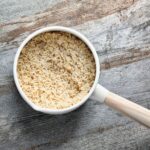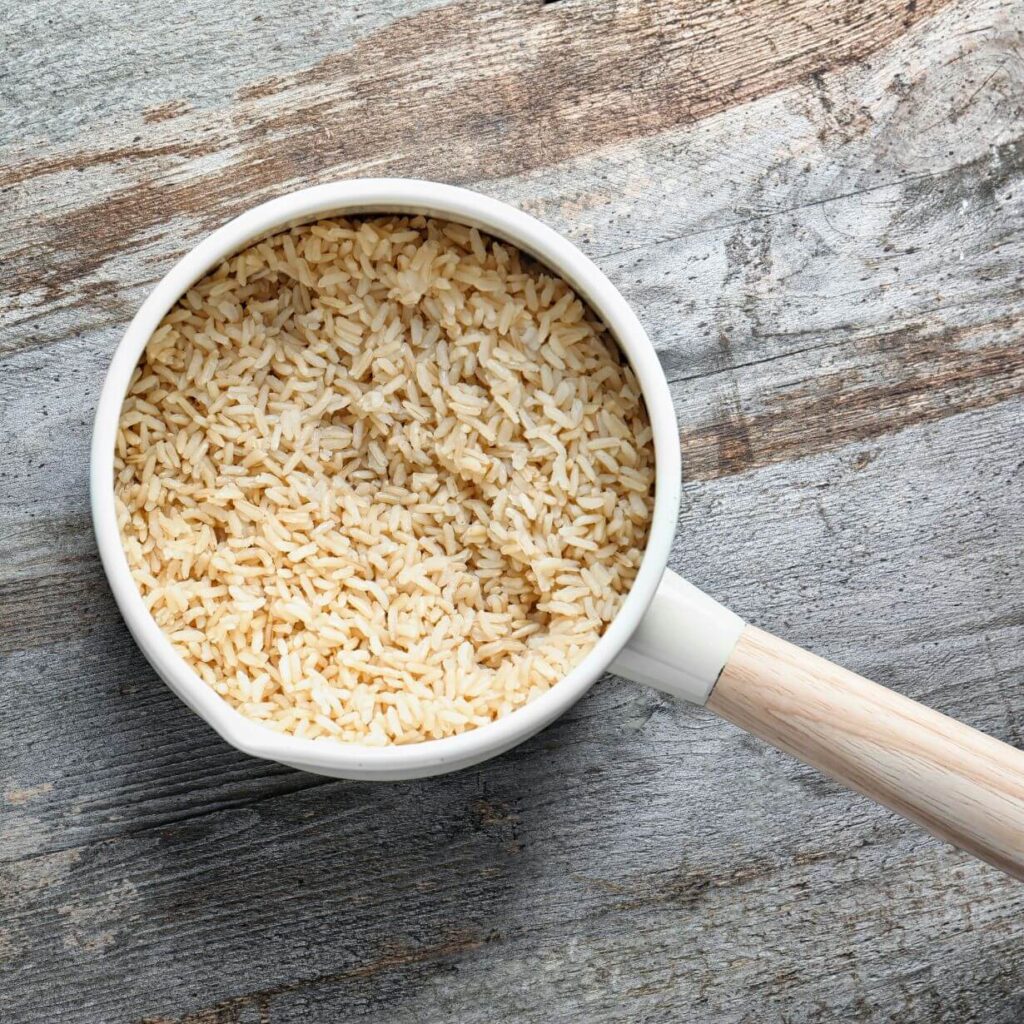
Rice can easily turn any meal into a scrumptious feast, it’s the perfect side dish or base of a healthy dinner. Learning how to cook rice is an essential kitchen skill, and it’s easy to master. All you need to make perfectly fluffy and tender rice is a saucepan, water, rice, a pinch of salt and a bit of patience. No fancy rice cookers or equipment needed!

Types of rice and their varieties
Rice can be classified by grain length – short, medium and long. The length of the grain is an indicator of the final texture of the cooked rice and this will help you to choose the right rice for your meal.
| Short-grain rice | Medium-grain rice | Long-grain rice | |
| Grain size | Less than twice as long as they are wide | Shorter and wider kernel than long grain rice | At least three to four times as long as they are wide |
| Texture | Soft, tender and sticky (clumps together when cooked) | Chewy, tender and slightly sticky | Light, fluffy and separates (won’t clump together when cooked because it’s lower in starch) |
| Perfect for | Sushi and poke bowls | Risotto and paella | Bowls, pilaf and biryani |
| Varieties | Black rice and sushi rice | Arborio | Basmati, brown long grain and jasmine |
Brown vs white rice
There are a variety of rice colours, including red, black, and purple. But the two most common are brown and white rice.
- Brown rice: Brown rice has its outer hull removed, but keeps its bran and germ layers intact. These layers give it the brown colour and make the texture a bit chewier, with a nuttier taste. It’s considered a whole grain and has more fibre and nutrients, with a lower glycemic index.
- White rice: White rice undergoes the entire milling process. This removes the husk, bran, and germ layers, leaving you with the endosperm, which is bright white in colour. It’s considered a processed grain and doesn’t have quite the nutritional profile as brown rice, but some may find it easier to digest. It also cooks faster.
Aromatic rice: basmati and jasmine
Two popular varieties of long grain rice are basmati and jasmine, which are also considered aromatic:
- Basmati: Long and slender, basmati is notable for its distinct nutty flavour and unique, slightly floral aroma. Basmati has a slightly softer grain than jasmine rice.
- Jasmine: Jasmine has a subtle floral aroma with a slightly sweeter taste and is more aromatic than basmati, with notes of buttered popcorn. Jasmine rice is commonly used in Thai and other Southeast Asian cooking.
Both basmati and jasmine are available in brown and white versions.
What about wild rice?
Wild rice is a grain produced from an aquatic grass that grows primarily in the Great Lakes region in North America. It’s quite long and has a firm, chewy and nutty texture. You can often find it in rice blends with other rice varieties, for a tasty and colourful option.
How much rice per serving?
Allow 60g (¼-cup) dried rice per serving and use double the volume of water to cook the rice. I always use measuring cups when cooking rice as it’s such an easy method and you don’t need to bother with scales.
How to cook rice
Soaking method
If you have the time, I recommend soaking rice before cooking which shortens the cooking time and improves digestibility.
Remember this sequence: rinse, soak, cook, rest and fluff:
- RINSE: Place the rice in a sieve and rinse thoroughly under running water until the water runs clear. You can rub the rice together with your hands to help the process. Drain well.
- SOAK: Place the rice in a large bowl and cover with warm filtered water. Add a 1 tablespoon of apple cider vinegar and leave to soak (see table for soaking time). Drain and rinse thoroughly.
- COOK: Place in a large saucepan and twice as much filtered water as the volume of the rice, plus ½ teaspoon of sea salt for every cup (250g) of rice. Cover and bring to a boil. Reduce the heat and simmer until the rice is tender and the water is absorbed (see table for cooking time). Do not stir the rice whilst cooking as this interferes with the cooking process.
- REST: Remove from the heat and leave the rice to sit for 5 minutes with the lid on.
- FLUFF: Fluff with a fork before serving.
| Rice type | Soaking time | Cooking time (after soaking) |
| Long grain brown rice | 4 hours | 30 minutes |
| Basmati brown rice | 2-4 hours | 15 minutes |
| Jasmine brown rice | 2-4 hours | 15 minutes |
| Wild rice | At least 4 hours | 30 minutes |
No time to soak?
Not to worry if you don’t have the time for the soaking, you’ll just need to adjust the cooking time. Check the labels and cook according to the packet instructions; the cooking time will increase without soaking.
Remember this sequence: rinse, cook, rest and fluff.
- RINSE: Place the rice in a sieve and rinse thoroughly under running water until the water runs clear. You can rub the rice together with your hands to help the process. Drain well.
- COOK: Place in a large saucepan and twice as much filtered water as the volume of the rice, plus ½ teaspoon of sea salt for every cup (250g) of rice. Cover and bring to a boil. Reduce the heat and simmer until the rice is tender and the water is absorbed (check the packet of your rice for cooking time). Do not stir the rice whilst cooking as this interferes with the cooking process.
- REST: Remove from the heat and leave the rice to sit for 5 minutes with the lid on.
- FLUFF: Fluff with a fork before serving.

Storing and freezing rice
If you’re going to the effort of soaking your rice before cooking then I recommend batch cooking and portioning it for meal prep, or storing in the freezer for later. The key to storing rice is to cool it quickly and then place it in the fridge immediately. You can cool it faster by spreading it on a plate or baking tray. Avoid leaving rice at room temperature for more than two hours as this can breed bacteria.
- Cooked rice will keep in an airtight container in the fridge for up to five days. Note that it may get a bit dry after a while, so splash a little water before reheating.
- Freeze cooked rice for up to three months. When you’re ready to eat, thaw it in the fridge overnight.
Using rice in recipes
- Basmati brown rice is part of this spicy burrito bowl.
- Serve jasmine brown rice with coconut cauliflower curry.
- Basmati brown rice goes well with easy chicken curry.
- Replace quinoa with basmati brown rice in this rainbow abundance bowl.
- Make your own abundance bowl. Layer up cooked rice of your choice with a veggie side, then add protein of your choice, like pulled pork, and tie everything together with a drizzle of salad dressing.
How to cook rice perfectly
Ingredients
- 250 g basmati brown rice
For soaking (optional)
- 1 tbsp apple cider vinegar
- 500 ml warm filtered water
For cooking
- 500 ml filtered water
- ½ tsp sea salt
Instructions
- RINSE: Place the rice in a sieve and rinse thoroughly under running water until the water runs clear. You can rub the rice together with your hands to help the process. Drain well.
- SOAK (OPTIONAL): Place the rice in a large bowl and cover with warm filtered water. Add the apple cider vinegar and leave to soak for 2 hours. Drain and rinse thoroughly.
- COOK: Place the rice in a large saucepan and add the filtered water and salt. Cover and bring to a boil. Reduce the heat and simmer until the rice is tender and the water is absorbed (about 15 minutes for soaked rice and 20-25 minutes for un soaked rice). Do not stir the grains whilst cooking as this interferes with the cooking process.
- REST: Remove from the heat and leave the grains to sit for 5 minutes with the lid on.
- FLUFF: Fluff with a fork before serving.
comments +